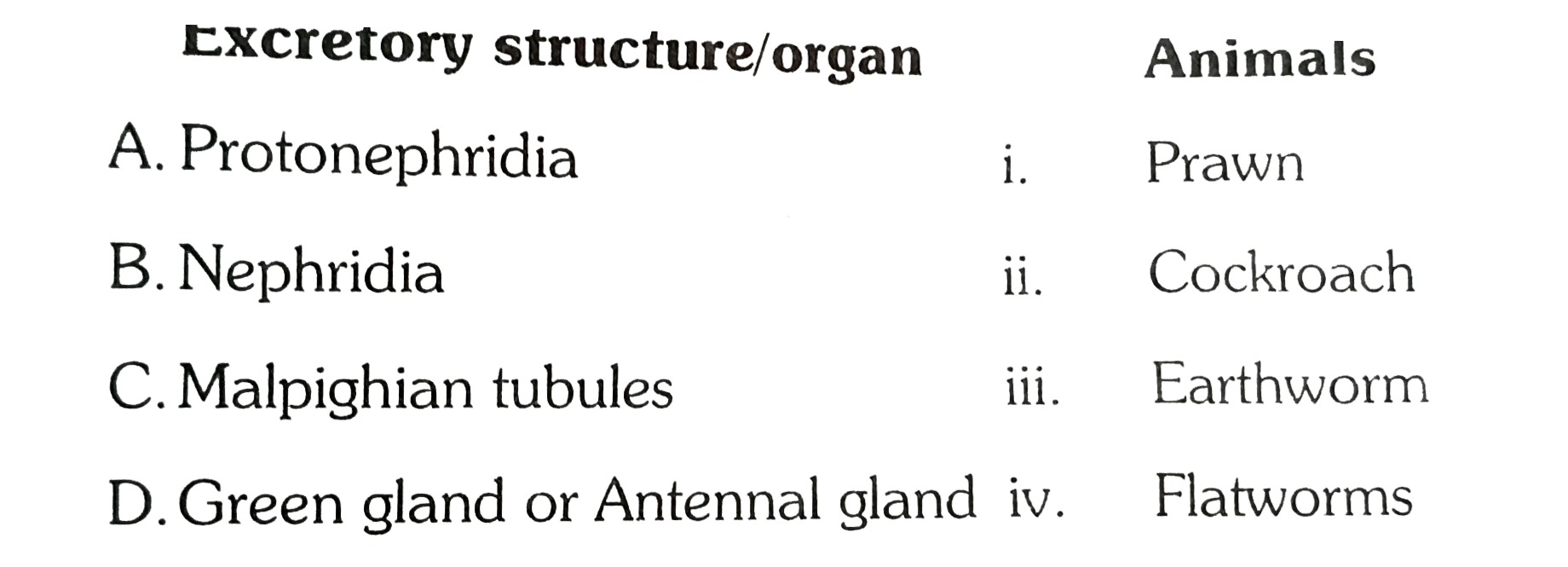Given below are respiratory structures and list of some animals . Match them appropriately.
Respiratory structures. Book gills pharyngeal wall lungs gills , book lungs , body surface , skin.
Animals . Pigeon , scopion , planaria , earthworm spiders , king crab, prawn , labeo ,
Pigeon-LungsSpiders - Book lungs Scorpion -Book lungs King crab - BookgillsPlanaria -Book surfacePrawn -Gills Earthworm -SkinLabeo -Gills
Topper's Solved these Questions
- BOOK - PRADEEPCHAPTER - BREATHING AND EXCHANGE OF GASES EXERCISE - Practice Questions (Multiple choice questions)60videos
BREATHING AND EXCHANGE OF GASES
- BOOK - PRADEEPCHAPTER - BREATHING AND EXCHANGE OF GASES EXERCISE - Practice Questions ( Assertion -Reason Type Questions)10videos
BREATHING AND EXCHANGE OF GASES
- BOOK - PRADEEPCHAPTER - BREATHING AND EXCHANGE OF GASES EXERCISE - Additional Question ( Long Answer Questions )14videos
BREATHING AND EXCHANGE OF GASES
- BOOK - PRADEEPCHAPTER - BODY FLUIDS AND CIRCULATIONEXERCISE - Practice Questions (II. Assettion-Resson Type Questions)11videos
BODY FLUIDS AND CIRCULATION
- BOOK - PRADEEPCHAPTER - CELL : THE UNIT OF LIFE EXERCISE - PRACTICE QUESTIONS(ASSERTION-REASON)33videos
CELL : THE UNIT OF LIFE
Similar Questions
Name the animal group having tracheae, book gill and book lungs as their respiratory organs.
View SolutionGiven below are four matchings of an animal and its kind of respiratory organ.
A. Silver fish - TracheaB. Scorpion - Book lungC. Sea squirt - Pharyngeal gill slitsD. Dolphin - Skin
The correct matchings areView Solution
Knowledge Check
- Question 1 - Select One
Different types of excretory structure and animals are given below . Match them appropriately and mark the correct answer from among those given below .
 A(D)i,(C)ii,(B)iiiand(A)ivB(B)i,(C)ii,(A)iiiand(B)ivC(D)i,(C)ii,(A)iiiand(B)ivD(B)i,(C)ii,(B)iiiand(A)iv
A(D)i,(C)ii,(B)iiiand(A)ivB(B)i,(C)ii,(A)iiiand(B)ivC(D)i,(C)ii,(A)iiiand(B)ivD(B)i,(C)ii,(B)iiiand(A)iv - Question 2 - Select One
Given below are four matchings of an animal and its kind of respiratory organ
(i). Silverfish - Trachea
(ii). Scorpion - Book lung
(iii). Sea squirt - pharyngeal gills
(iv). Dolphin - Gills
The correct matchings areAII and IVBIII and IVCI and IVDI , II and III - Question 3 - Select One
Given below are four matchings of an animal and its kind of respiratory organ.
A. Silver fish - TracheaB. Scorpion - Book lungC. Sea squirt - Pharyngeal gill slitsD. Dolphin - Skin
The correct matchings areAA and BBA,B and CCB and DDC and D
Respiratory system plays an important role of enabling gas exchange and supply of oxygen to the animals. Although, the basic mechanism of the system remains same , animals display variation in their respiratory system. In the following columns match the animals with their organ for respiration.
Animal Respiratory1KangarooPMoist cuticle2Pomfret QLungs3CockroachRGills4EarthwormSTracheal tubesView SolutionWilliam Harvey (1578–1657) was one of the early biologists who studied the bodies of humans and animals. He even dissected the bodies and did experiments with the heart and blood vessels. He concluded from his experiments that the blood leaves the heart through the arteries and returns via the veins. However, he could not explain how blood left the arteries to enter the veins. He said there must be some structure between arteries and veins but he could not find them. Marcello Malphigi (1628–1694) later discovered these structures while studying a dead frog's lungs under a microscope.
Which two chambers of the human heart have arteries connected to them?View SolutionWilliam Harvey (1578–1657) was one of the early biologists who studied the bodies of humans and animals. He even dissected the bodies and did experiments with the heart and blood vessels. He concluded from his experiments that the blood leaves the heart through the arteries and returns via the veins. However, he could not explain how blood left the arteries to enter the veins. He said there must be some structure between arteries and veins but he could not find them. Marcello Malphigi (1628–1694) later discovered these structures while studying a dead frog's lungs under a microscope.
Which of the following statements about arteries and veins is TRUE?View SolutionMatch column I with column II and select the correct option from the given codes.
Column IColumn II(Animals)(Respirartory structures)A. Pigeon (i) Book gillsB. Scorpion(ii) Pharyngeal wallC. Planaria(iii) LungsD. Earthworm(iv) GillesE. Spiders(v) Book lungsF. King crab(vi) Body surfaceG. Prawn(vii) SkinH. LabeoView SolutionWilliam Harvey (1578–1657) was one of the early biologists who studied the bodies of humans and animals. He even dissected the bodies and did experiments with the heart and blood vessels. He concluded from his experiments that the blood leaves the heart through the arteries and returns via the veins. However, he could not explain how blood left the arteries to enter the veins. He said there must be some structure between arteries and veins but he could not find them. Marcello Malphigi (1628–1694) later discovered these structures while studying a dead frog's lungs under a microscope.
What is the MOST LIKELY reason why Harvey could NOT find these structures?View Solution

